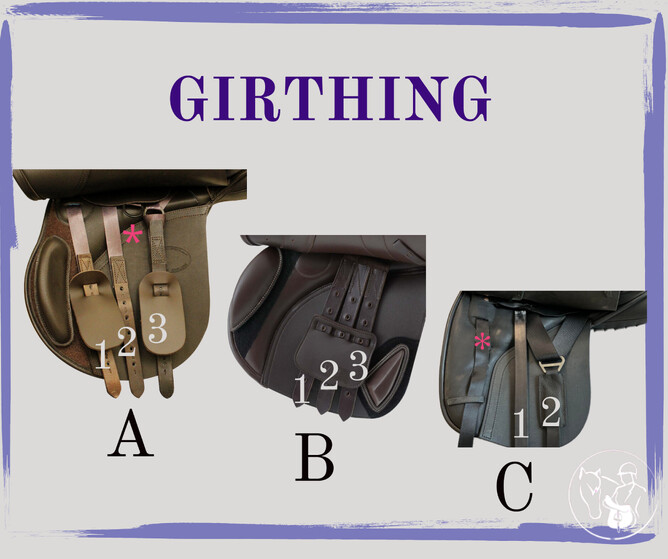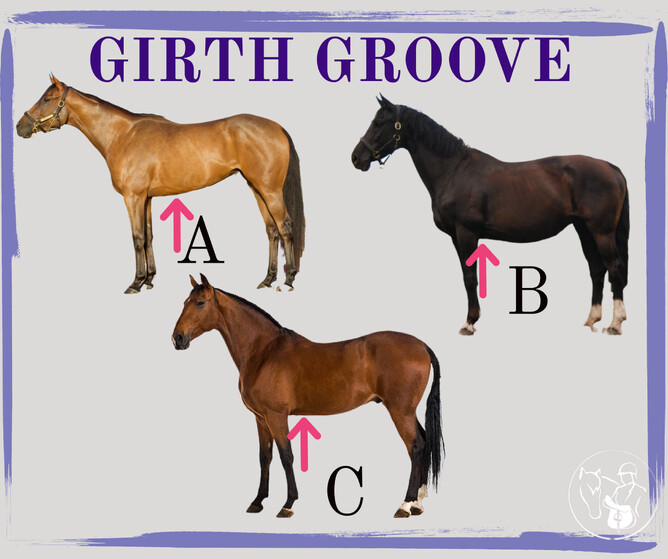This is quite a complicated subject and a topic that many people have a varied view on.
The overview of girthing is that it is what we use to hold the saddle onto the horse's back.
So why is it so complicated?
Firstly there is a variety of girthing options available on saddles. Some saddles have 2 straps, some have 3 or even up to 5 straps, some have straps that can be moved by moving a strap on a loop, some have to be stitched on in a new place, and some can't be moved at all.
Secondly, where the girth needs to sit is in your horses girth groove- which is individual to the horse (and can change with the level of weight and fitness the horse has)
Why are there so many girthing options? Lets look at the first picture below.
A) Has 3 girth straps and an which shows where we can move the very back strap from 3 to the placement. This can be done at home as it’s just a loop strap.. Strap number 1 is also called the POINT STRAP (and strap number 2 is actually called the front strap!)
B) Has ‘standard’ girthing, with 3 central girth straps.
C) Has a point strap and then 2 straps. A front strap and 2 is on a “Y” web. This shows where the girth tab is and the strap can be taken off the 1 position and stitched onto the * (point strap) position.
So the reason we have various types of girthing is so that we can match the girthing on the saddle to the horses girth groove conformation (this is the narrowest spot behind the elbows and end of the sternum) .
Look at the second picture.
A) Is a horse we call “herring gutted” or has a back positioned girth groove - there is no ‘spot’ that the girth will nestle into nicely, the narrowest part of the horse is up by it’s flank (NOT where we want our saddle to end up!). Some horses naturally have this conformation, others can develop it when they become fit.
B) Is a horse we say has a “forward girth groove” - the narrowest part of the horse is forward of the end of the sternum, very close to the back of the elbow. Saddles will want to slide forward into this groove, usually onto the shoulder.
C) Is a horse with a regular girth groove. Nothing complicated here, you can get your recommended hand between the back of the elbow and the girth. You can use a range of girths and the saddle stays nicely in place with regular girthing (pic B in the top photo).
How do you choose the right option for your horse and saddle? This is where girthing options come into play. Lets talk about the girth straps, and why they are used.
Let’s start with standard girthing (top pic, image B). This is the original girthing that has been traditionally used with the start of English saddles. It is said to be the kindest girthing as the pressure is taken through the middle of the saddle, with less pressure in the front and rear of the saddle to allow for the muscles to move easily under the saddle.
It is designed to use on horses that have a good girth groove that the straps can naturally sit above.
If the horse has a forward or back girth groove this girthing may allow the saddle to move into the girth space and slide forward or back causing issues.
The POINT strap. This strap needs a post all of it’s own. (top pic, image A1) Love it or hate it, it’s well talked about, and incorrectly used can cause issues.
The point strap is named as it comes down directly above or off the tree point. It is hated by some people because it comes off the very front of the tree point it does have the ability to pull the saddle down and pull the tree points into the shoulder (especially if the tree width is wrong or the panel is thin/ foam).
It is used a lot for horses/ ponies who have a forward girth groove as this is the only girth placement on the saddle that will line up naturally with a forward girth groove, or can hold a saddle in place to reduce the chance of it slipping back on a herring gutted shape.
The point strap must NEVER be used in conjunction with the first strap as you pull the saddle down at the front only and unbalance the saddle (and make it uncomfortable for the horse), so you must use them with a balance strap (top pic, image A * or 3) to apply pressure through the whole tree.
Caution must be used for horses with high and/or long withers to make sure they still have wither clearance with use of the point strap.
The benefit of the saddle staying in place and off the back of the very sensitive and easy to damage, cartilage out weighs not using the point strap, as does keeping the saddle from sliding back into the easy to damage lumbar area.
Most saddles with a point strap have a good panel to add support & protection to the front of the saddle to provide good comfort for the horse.
First strap
The first strap is the first one behind the tree point (as not all saddles have point straps) and is commonly used in conjunction with the back balance strap. Occasionally it can be used with a middle strap, but it’s not the usual configuration.
Middle Strap
The middle strap, is often used in conjunction with the back balance strap, or other straps if the horse requires asymmetrical girthing.
Balance/ Back balance straps
This the last strap on the saddle, or for those that have adjustable girthing, the last two options (top pic, image A * or 3). These are either used in conjunction with either the point strap, first strap, or the middle strap and ae used for keeping pressure in the back end of the saddle.
“Y” Girthing
This is traditionally seen on the back of monoflaps or dressage saddles (top pic, image C2) . It is the webbing attachment (what attaches the girth strap to the tree) which fixes to a central and rear placement to add pressure through the back half of the saddle. Used to let the girth strap have some natural movement to be able to ‘slide’ into the horses girth groove.
So, it depends on your horses girth groove statically and in motion as to which girthing options are selected for you to keep the saddle in place and straight.
Take home note: If you have a particular girthing arrangement recommended by your saddle fitter, please don’t change it because it’s not what your coach/ friend would use without a conversation with your fitter.
What are the different girthing options available for saddles?
Saddles come with various girthing setups, including traditional three-strap designs, point straps, and Y-shaped girthing used in dressage saddles. The choice of girth depends on your horse's girth groove conformation and helps secure the saddle in place to prevent it from slipping.
How does my horse's girth groove affect the choice of girthing?
The girth groove is the narrowest part of your horse's body, located behind the elbows. Horses with different types of girth grooves—forward, back, or regular—require specific girthing options to ensure a secure and comfortable fit. A saddle fitter can help determine the best girthing arrangement for your horse's unique conformation.
What is the point strap and when should it be used?
The point strap is a girth strap located at the front of the saddle, above the tree point. It is primarily used for horses with a forward girth groove or herring gutted conformation. The point strap should be paired with a balance strap to avoid uneven pressure and ensure the saddle stays securely in place.






